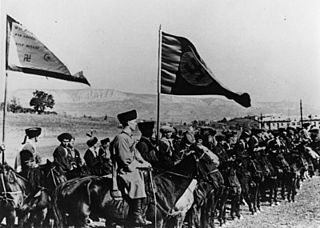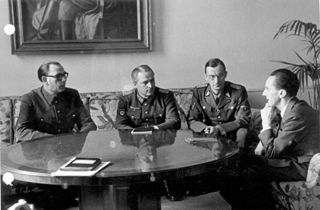Related Research Articles

The Luftwaffe was the aerial-warfare branch of the German Wehrmacht before and during World War II. Germany's military air arms during World War I, the Luftstreitkräfte of the Imperial Army and the Marine-Fliegerabteilung of the Imperial Navy, had been disbanded in May 1920 in accordance with the terms of the 1919 Treaty of Versailles which banned Germany from having any air force.

Organisation Todt was a civil and military engineering organisation in Nazi Germany from 1933 to 1945, named for its founder, Fritz Todt, an engineer and senior Nazi. The organisation was responsible for a huge range of engineering projects both in Nazi Germany and in occupied territories from France to the Soviet Union during World War II. It became notorious for using forced labour. From 1943 until 1945 during the late phase of the Third Reich, OT administered all constructions of concentration camps to supply forced labour to industry.

Fritz Todt was a German construction engineer and senior Nazi who rose from the position of Inspector General for German Roadways, in which he directed the construction of the German autobahns (Reichsautobahnen), to become the Reich Minister for Armaments and Ammunition. From that position, he directed the entire German wartime military economy.
Mountain Corps Norway was a German army unit during World War II. It saw action in Norway and Finland.

The Reich Labour Service was a major organisation established in Nazi Germany as an agency to help mitigate the effects of unemployment on the German economy, militarise the workforce and indoctrinate it with Nazi ideology. It was the official state labour service, divided into separate sections for men and women.

Ostlegionen, Ost-Bataillone, Osttruppen, and Osteinheiten were units in the Army of Nazi Germany during World War II made up of personnel from the Soviet Union. They were a large part of the Wehrmacht foreign volunteers and conscripts.

Technische Nothilfe was a German organisation. It began as a strikebreaker organisation after the First World War, but developed into a volunteer emergency response unit. During the Nazi period TN became in charge of technical civil defence.

Between 1933 and 1945, the organization of the Luftwaffe underwent several changes. Originally, the German military high command, for their air warfare forces, decided to use an organizational structure similar to the army and navy, treating the aviation branch as a strategic weapon of war. Later on, during the period of rapid rearmament, the Luftwaffe was organized more in a geographical fashion.

Alfred Schlemm was a German General der Fallschirmtruppe in the Wehrmacht. His last command in World War II opposed the advance of the First Canadian Army through the Reichswald in February 1945.

Anton Hafner was a German Luftwaffe military aviator during World War II and a fighter ace credited with 204 enemy aircraft shot down in 795 combat missions. The majority of his victories were claimed on the Eastern Front, but he also claimed 20 victories over the Western Front during the North African Campaign.

The Wehrmacht was the unified armed forces of Nazi Germany from 1935 to 1945. It consisted of the Heer (army), the Kriegsmarine (navy) and the Luftwaffe. The designation "Wehrmacht" replaced the previously used term Reichswehr and was the manifestation of the Nazi regime's efforts to rearm Germany to a greater extent than the Treaty of Versailles permitted.

The Heer as the German army and part of the Wehrmacht inherited its uniforms and rank structure from the Reichsheer of the Weimar Republic (1921–1935). There were few alterations and adjustments made as the army grew from a limited peacetime defense force of 100,000 men to a war-fighting force of several million men.

A large number of Soviet citizens of various ethnicities collaborated with Nazi Germany during World War II. It is estimated that the number of Soviet collaborators with the Nazi German military was around 1 million.
The Ranks and insignia of the Luftwaffe were the ranks used by Luftwaffe, from its founding in 1933 to the end of World War II in 1945. The ranks were similar to other air forces at the time, however, some Luftwaffe ranks had no equivalent in the Allied air forces. While many ranks might have equivalents in other air forces, in reality the Luftwaffe military had a far greater responsibility; while officers of the Royal Air Force, the British Air Force, were graded to a higher rank when performing higher rank functions, Luftwaffe officers maintained their rank while performing functions, regardless of size of the responsibility assigned to them.

Among the approximately one million foreign volunteers and conscripts who served in the Wehrmacht during World War II were ethnic Belgians, Czechs, Dutch, Finns, Danes, French, Hungarians, Norwegians, Poles, Portuguese, Swedes, along with people from Great Britain, Estonia, Latvia, Lithuania, and the Balkans. At least 47,000 Spaniards served in the Blue Division.
Sonderführer, abbreviated Sdf or Sf, was a specialist role introduced in the Wehrmacht of Nazi Germany in 1937 for the mobilization plan of the German armed forces.
Luftwaffe personnel structure consisted of two broad categories, Wehrmachtangehörige or members of the armed forces, and Wehrmachtgefolge or auxiliaries of the armed forces.
Transportkorps Speer was created in 1944 from Legion Speer and the units of the National Socialist Motor Corps that was serving the Organisation Todt. Shortly after its creation it became subordinated to the Wehrmacht. Yet, its major mission remained in support of OT, which at this time was mainly engaged in rebuilding and repair of bomb damaged industrial facilities and housing complexes. Transportkorps Speer was organized in motor transportation battalions and regiments, supported by depot, repair, engineering, signal, and medical units.
The Ranks and insignia of German Women's Auxiliary Services were the ranks given to women who served in the German military and paramilitary forces during World War II.
References
Notes
Cited literature
- Henner, Sigurd & Böhler, Wolfgang (2014). Die Deutsche Wehrmacht. Dienstgrade und Waffenfarbe der Luftwaffe 1939-1945. Stuttgart: Motorbuch Verlag.
- Thomas, Nigel & Caballero Jurado, Carlos (2000). Wehrmacht Auxiliary Forces. Oxford: Osprey Publishing.
- United States War Department (1945). Handbook on German military forces. TM-E 30-451. Washington, DC: United States Government Printing Office. [Cited as TM-E 30-451]